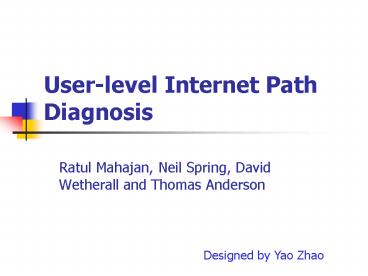User-level Internet Path Diagnosis PowerPoint PPT Presentation
Title: User-level Internet Path Diagnosis
1
User-level Internet Path Diagnosis
- Ratul Mahajan, Neil Spring, David Wetherall and
Thomas Anderson
Designed by Yao Zhao
2
A distributed system is one in which the failure
of a computer you didnt even know existed can
render your own computer unusable.
- L. Lamport
3
Motivation
- Can end users, with no special privileges
identify and pinpoint faults inside the network
that degrade the performance of their
applications? - Why (unprivileged) end users?
- Operators do not share the users view of the
network - Operators may have no more insight than
unprivileged users for problems inside other
administrative domains - user can directly contact the responsible ISP
leading to faster problem resolution - Many techniques are more effective and scalable
with fault localization than blindly trying all
possibilities
4
Outline
- Diagnosis architecture
- Diagnosis Tool Tulip
- Evaluation
- Recommendations
- Conclusion
5
Problem
6
An Ideal Trace-based Solution
- Routers log packet activity and make these traces
available to users. - The log at each router is recorded for both input
and output interfaces. - impractical for deployment
7
Packet-based Solutions
- Complete Embedding
- Each router along the path records information
into each packet that it forwards. - Barring two exceptions, the scheme above is
equivalent to the path trace. - Reduced Embedding
- Remove the step of embedding the complete input
packet in the output packet - Constant Space Embedding
- Sample TTL
- Real Clocks
- Unsynchronized clock
- Finite precision
8
New Fields of Packet Header in the Architecture
9
Outline
- Diagnosis architecture
- Diagnosis Tool Tulip
- Evaluation
- Recommendations
- Conclusion
10
Internet Approximations
- Out-of-band measurement probes
- ICMP timestamp requests to access time at the
router - IP identifiers instead of per-flow counters
11
Packet Reordering
12
Assumptions for Packet Loss
- IP-IDs are consecutive
- 80 of the time from over 90 of the routers
- Small size packets usually have low loss rate
- In over 60 of the cases when any packet in the
triplet was lost, only the data packet was lost. - ICMP rate-limiting will not be mistaken as packet
loss - 1 more check packet
13
Packet Loss
14
Packet Queuing
- Similar to cing
- Two practical problems
- ICMP generation time
- Cable modems and wireless links
15
Tulip
- Network Load
- BL/W
- Diagnosis time
- 10 30 min per path
- Parallel search vs Binary search
- Two or more faults?
16
Outline
- Diagnosis architecture
- Diagnosis Tool Tulip
- Evaluation
- Recommendations
- Conclusion
17
Methodology
- Evaluate applicability
- Diagnosis granularity
- Three sources MIT, U Washington and London
- Destinations from Skitter
- Validation
18
Diagnosis granularity (1)
19
Diagnosis granularity (2)
20
Validation
- IP-IDs and ICMP timestamp vs End-to-end
measurement - Tulip vs Sting
- Consistency of Tulips inferences
- Consistency between Tulip and Paths
21
Two facts
- Locating Loss and Delay in the Internet
- Persistence of Faults
22
(No Transcript)
23
Outline
- Diagnosis architecture
- Diagnosis Tool Tulip
- Evaluation
- Recommendations
- Conclusion
24
Limitations of Tulip
- Out-of-band measurements
- Stable routing path
- IP-ID counters
- Limitations of ICMP timestamps
25
In-band vs Out-of-band Diagnosis
- Priority of protocols
- Packet drop
- Packet size
- Loss rate
- Reordering
26
Other Recommendations
- Path Verification
- IP Identifiers
- Router Timestamps
27
Related Works
- Diagnosis Approaches
- Magpie
- SPIE
- NetFlow
- Measurement Primitives
- Overlay primitives
- IPMP
- Measurement Tools
- PING, Traceroute, pathchar, Sting
28
Conclusion
- Tulip
- Practical tool to diagnose packet reordering,
loss and queuing - Diagnosis architecture
- In-band
- Lightweight
29
Questions?

